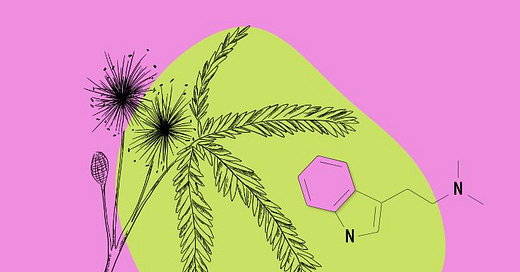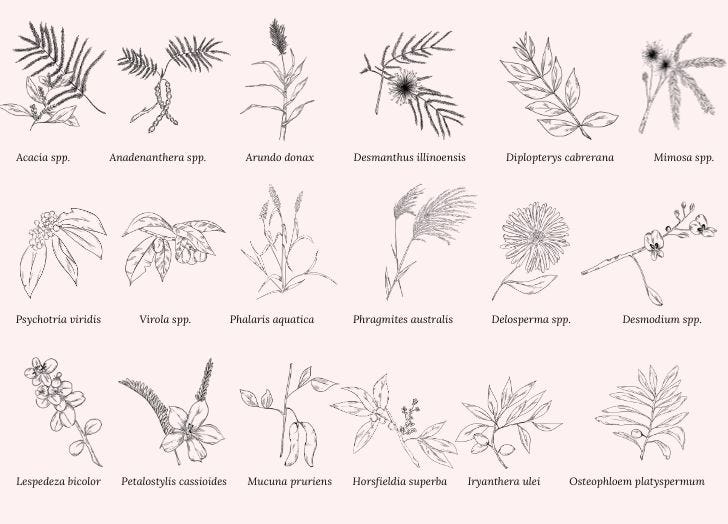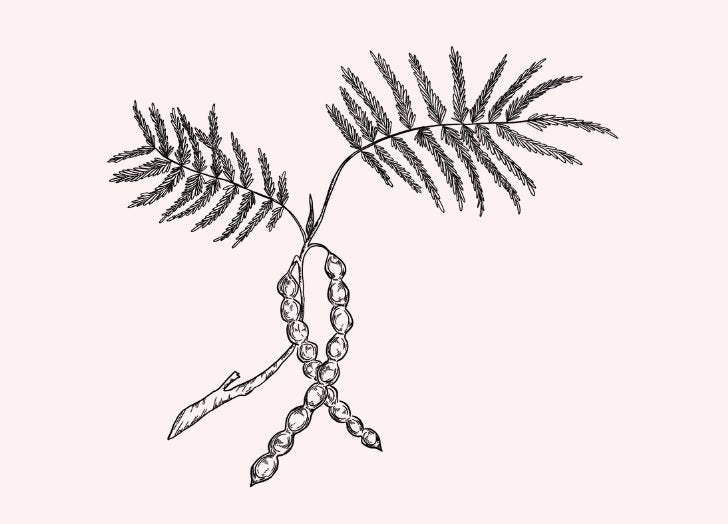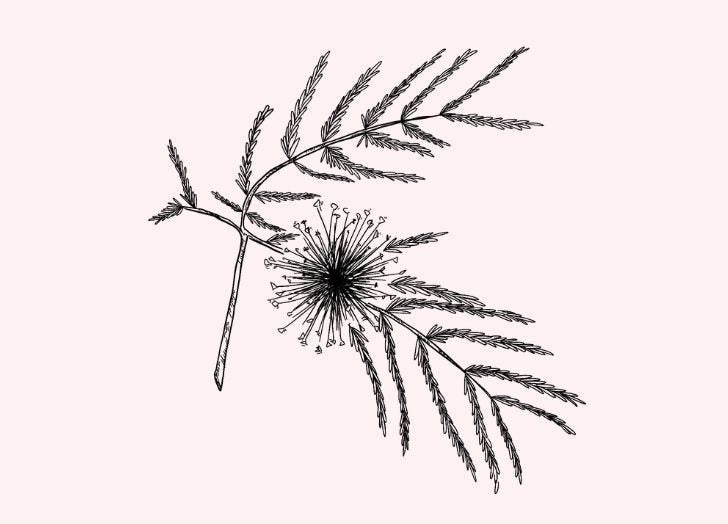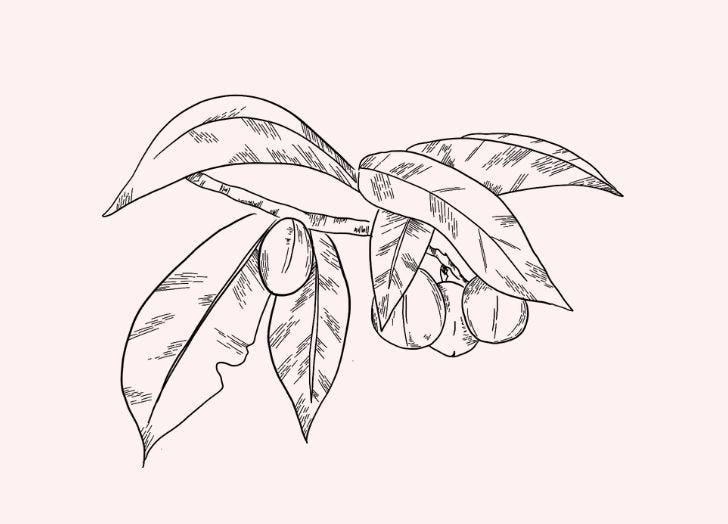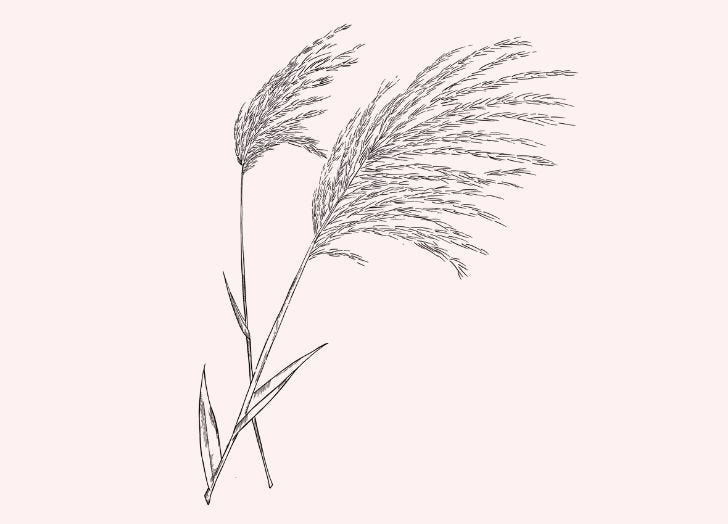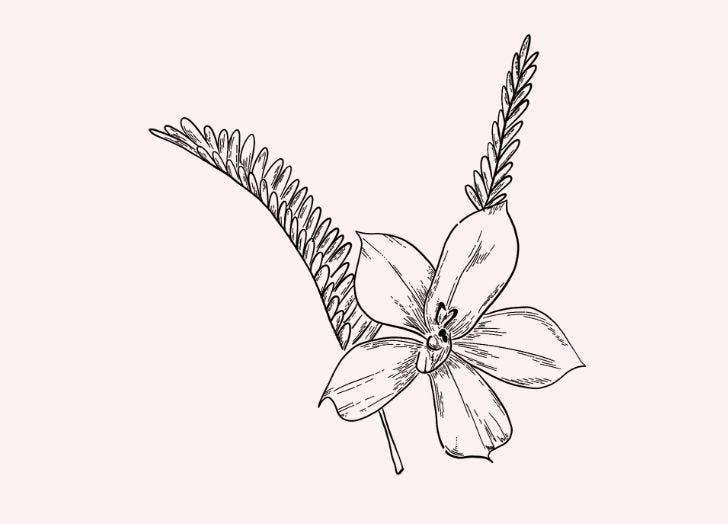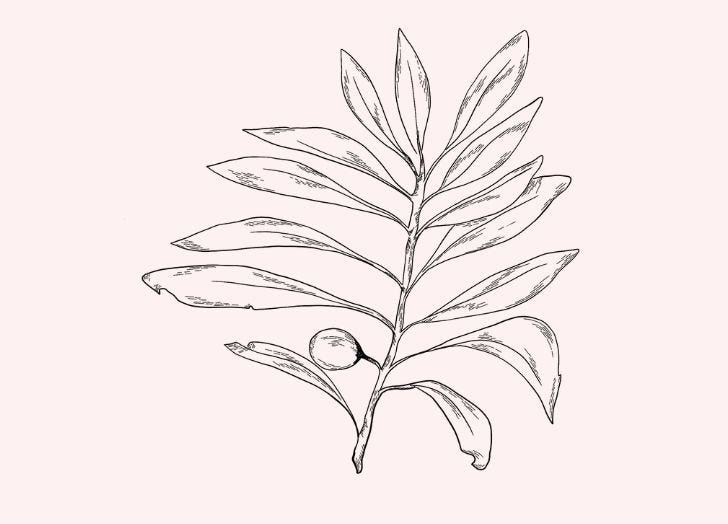The Botanical World is Full of DMT 🌱
DMT is surprisingly common in nature. It’s found in many plants, animals, and even a few species of sea sponges. Here are some of the most notable plant-based sources of DMT.
Thousands of plant species produce DMT — even the rinds of a few common citrus fruits contain (some) DMT.
The reason we don’t blast off every time we eat a lemon is because our body is very efficient at disabling DMT before it takes effect.
Monoamine oxidase (MAO) — an enzyme embedded inside almost every cell in the human body — vigilantly destroys any and all DMT it discovers on sight. It’s extremely efficient. We could drink large quantities of DMT and feel virtually no effect because of this enzyme.
DMT only becomes psychoactive when we smoke, snort, or mix it with other plants (or synthetic chemicals) that block this enzyme. The most common group of compounds used for this are the harmala alkaloids, which are found in plants such as the ayahuasca vine (Banisteriopsis caapi), tobacco (Nicotiana tabacum), and Syrian rue (Peganum harmala).
Most DMT-containing plants produce a combination of N,N,DMT, 5-MeO-DMT, and 5-HO-DMT (AKA “bufotenin”). The ratio of these different forms of DMT varies depending on species, environmental conditions, and the time of year the plant was harvested.
Here, we explore 18 notable plant species that produce either N,N,DMT or 5-MeO-DMT.
List of Plants That Contain DMT
DMT is more common in a few specific families of plants than others.
The pea family (Fabaceae) is home to the most ambitious of the DMT-containing plants. This includes genera such as Mimosa, Acacia, Petalostylis, Desmodium, Mucuna, and Lespedeza — just to name a few.
The other most predominant family of herbs that take the time to make DMT is the nutmeg family (Myristicaceae). Notable DMT-containing members of this family include Horsfieldia and Virola. Nutmeg itself is psychedelic as well, but not because of DMT. This herb relies on a psychoactive terpene called myristicin — which acts as a powerful deliriant.
Other notable plant genera that produce DMT include Phalaris, Delosperma, and Psychotria.
1. Acacia spp.
Family: Fabaceae
Distribution: Australia & Africa
The acacia genus contains around 160 different species — most of which are found in Australia and Africa.
Acacia trees are a rich plant source of DMT. Dozens of species have been confirmed to contain a combination of N,N,DMT, 5-MeO-DMT, bufotenin, and related tryptamine alkaloids.
Some species, such as Acacia berlandieri, contain other psychoactive alkaloids, too, including mescaline, amphetamines, and nicotine.
2. Yopo (Anadenanthera spp.)
Family: Fabaceae
Distribution: Caribbean & South America
Yopo (also called Jopo or Cohoba) is a tropical tree species found throughout the Amazon and parts of the Caribbean.
The beans of the yopo tree contain relatively high concentrations of bufotenin (7.4%) and related tryptamine alkaloids, including 5-MeO-DMT (0.04%) and N,N,DMT (0.16%).
3. Giant River Reed (Arundo donax)
Family: Poaceae
Distribution: Middle-East, Western USA, Pacific Islands
Arundo donax is a species of cane found throughout the Middle East, California, the Caribbean, and the islands of the West Pacific.
This plant goes by many common names — just a few examples include giant cane, elephant grass, carrizo, arundo, Spanish cane, Colorado river reed, and wild cane.
The whole plant contains a pharmacy of tryptamines, including N,N,DMT (0.0057%), 5-MeO-MMT (0.0023%), 5-MeO-NMT, and bufotenine (0.026%).
4. Bundleflower (Desmanthus illinoensis)
Family: Fabaceae
Distribution: Midwestern USA
Many members of the Desmanthus genus contain DMT and related tryptamine alkaloids. The bundleflower (Desmanthus illinoensis) contains the highest concentration of N,N,DMT at around 0.34% in the root bark.
5. Chagro-Panga (Diplopterys cabrerana)
Family: Malpighiaceae
Distribution: Brazil, Colombia, Ecuador & Peru
Diplopterys cabrerana is an Amazonian vine sometimes used as an alternative to chacruna for making ayahuasca. It contains high concentrations of N,N,DMT (1.3%), and trace amounts of 5-MeO-DMT and other tryptamine alkaloids, including bufotenin and methyltryptamine.
The leaves of the plant also contain trace amounts of beta-carboline — which is a common MAO inhibitor used to activate DMT found in other plants.
6. Jurema (Mimosa spp.)
Family: Fabaceae
Distribution: Southeast Asia & South America
There are more than 400 species in the Mimosa genus — many of which contain notable quantities of DMT.
By far, the most common species used for making ayahuasca or extracting DMT are Mimosa hostilis and Mimosa pudica. The root bark of Mimosa hostilis (formerly Mimosa tenuiflora) contains roughly 1.7% N,N,DMT by dried weight. The stem bark also contains DMT, but in much lower concentrations (0.3%).
7. Chacruna (Psychotria viridis)
Family: Rubiaceae
Distribution: Central & South America
Chacruna can be found throughout the Amazon rainforest and is cultivated by local farmers for its use as a key ingredient in ayahuasca.
Any DMT-containing plant can be used in combination with the ayahuasca vine (Banisteriopsis caapi) to make the ayahuasca brew — but chacruna is by far the most common species used.
The leaves of chacruna contain anywhere from 0.1% to 0.6% N,N,DMT by dried weight.
8. Epeña (Virola spp.)
Family: Myristicaceae
Distribution: Mexico, Central America, & South America
Virola is a genus of trees related to nutmeg (Myristica fragrans). The leaves, bark, roots, and flowers of this tree contain varying amounts of N,N,DMT, and 5-MeO-DMT.
The powdered resin of Virola species is insufflated as an entheogen by various indigenous Amazonian tribes — such as the Yanomami. It’s used in a similar context to yopo and is sometimes used as an alternative for making ayahuasca.
9. Bulbous Canary Grass (Phalaris aquatic)
Family: Poaceae
Distribution: North America & Australia
Phalaris is a species of grass found on every continent except Antarctica. This genus is incredibly diverse — found in virtually any landscape. Phalaris aquatica prefers marshy wetlands and is an invasive species in many parts of the world.
Various species of Phalaris contain tryptamine alkaloids such as N,N-DMT (0.1%), 5-MeO-DMT (0.2%), and bufotenin (0.005%).
This species is not considered a safe alternative to other DMT-containing plants for the purpose of making ayahuasca or extracting DMT.
10. Common Reed (Phragmites australis)
Family: Poaceae
Distribution: Canada, USA, Australia
This wetland species of reed grows up to 6 meters tall and can spread laterally nearly 5 meters per year. It’s tolerant to droughts, brackish water, and high temperatures. These characteristics allow the common reed to flourish in just about any wetland bog it manages to sink its roots into.
All parts of this plant contain modest concentrations of N,N,DMT, 5-MeO-DMT, and bufotenin.
11. Delosperma spp.
Family: Aizoaceae
Distribution: South Africa
Delosperma is a genus of drought-resistant succulents with brightly colored, long-lasting flowers. They’re abundant in South Africa and are a popular garden variety in other hot, arid parts of the world.
The leaves of delosperma contain both N,N,DMT and 5-MeO-DMT, which shift throughout the year. N,N,DMT content is higher in plants harvested in the winter, while 5-MeO-DMT concentrations are highest in the summer.
12. Desmodium spp.
Family: Fabaceae
Distribution: South America
There are several species of Desmodium that contain DMT, including D. caudatum. D. gangeticum, D. gyrans, and others.
Several DMT-containing Desmodium species have been moved to other taxonomic groupings, such as Phyllodium pulchellum, which contains N,N,DMT, 5-MeO-DMT, and bufotenin.
Some research suggests the species Desmodium gangeticum has the highest concentration of DMT of the genus — with around 0.057% N,N,DMT by dried weight.
The roots and leaves are used to extract DMT, but only plants that are two years old or older contain any detectable concentrations of DMT.
13. Shrubby Bushclover (Lespedeza bicolor)
Family: Fabaceae
Distribution: East Asia
Lespedeza bicolor is a small shrub found throughout Asia. It’s often used as an ornamental garden variety. It’s fast-growing but doesn’t overcrowd neighboring plants.
Unsurprisingly, this herb is another DMT-containing member of the Fabaceae (pea) family. The leaves and root bark of the plant contain both N,N,DMT and 5-MeO-DMT (concentrations unknown).
14. Butterfly Bush (Petalostylis cassioides)
Family: Caesalpiniaceae
Distribution: Australia
The butterfly bush is a native Australian plant with prominent butterfly-shaped flowers. It contains around 0.5% tryptamine alkaloids by dried weight in the seeds and leaves.
The only study available examining the DMT levels of this plant (from the 1970s) suggests it contains several tryptamine alkaloids, including tryptamine, N,N-dimethyltryptamine, N-methyltryptamine, and tetrahydroharman.
The seeds are reported to have a “tryptamine smell” when crushed open.
15. Velvet Bean (Mucuna pruriens)
Family: Fabaceae
Distribution: Southeast Asia
Velvet bean is a popular nootropic supplement for its high L-Dopa and 5-HTP concentrations. L-Dopa is a precursor for dopamine, and 5 HTP is a precursor for serotonin. Dopamine and serotonin are two key neurotransmitters in the human brain.
More recently, research has discovered Mucuna pruriens also contains modest amounts of N,N,DMT, bufotenin, 5-MeO-DMT, and nicotine.
There isn’t enough DMT in this plant to be worth using it for extraction. The leaves and seeds contain somewhere in the ballpark of 3 micrograms per gram. This means that for a single 5 mg dose of DMT, you’d need nearly 2 kg of leaves — which simply isn’t practical.
16. Pendarah (Horsfieldia superba)
Family: Myristicaceae
Distribution: Southeast Asia
This plant is a member of the nutmeg family (Myristicaceae), native to Sumatra, Malaysia, and Singapore. It has a long history of use as an herbal medicine for managing chronic pain but is currently listed as critically endangered due to habitat loss in this rapidly developing region of the world.
The bark contains 5-MeO-DMT, beta-carboline (an MAO inhibitor), and an alkaloid with analgesic effects called horsfiline.
17. Iryanthera ulei
Family: Myristicaceae
Distribution: South America
Iryanthera ulei is a tall tree native to the Amazon rainforest.
There isn’t much information on this plant or how it’s used. We don’t have any data specifying the specific concentrations of DMT in the plant, but there are reports that it contains both 5-MeO-DMT and N,N,DMT in “notable concentrations.”
18. Osteophloem platyspermum
Family: Myristicaceae
Distribution: Central & South America
Osteophloem platyspermum is the only listed species in the genus. It’s a species of tree found primarily in Panama.
There’s very little information available about this species of plant and virtually no formal studies. The only data we have available about the DMT concentrations of this plant comes from a field study published by Harvard University back in 1980.
The report suggests Osteophloem platyspermum contains both N,N,DMT and 5-MeO-DMT in unspecified concentrations.
Why Role Does DMT Play in Nature?
While this is up for debate, the general consensus among scientists is that plants produce DMT to protect themselves from insects and animals.
Several studies have shown that plants containing high concentrations of tryptamine alkaloids (including DMT) are preyed on less often than plants that don’t produce these compounds [#1, #2].
DMT, serotonin, and other tryptamines are toxic to many species of insects and interfere with feeding, reproduction, and immune function. These compounds can also negatively affect mammals that may seek to feed on these plants — especially in high concentrations.
A good example of this is the “phalaris staggers” that cause grazing animals to lose their ability to coordinate movement after eating large amounts of Phalaris grass.
There are species of sea sponges that produce a type of DMT called 5-Bromo-DMT (Spongebob DMT) as a way to repel barnacles and other mollusks from growing on the surface and clogging the creature’s airway.
The Colorado River toad (Bufo alvarius) uses a similar method to avoid being eaten. It secretes a venom on its back that contains high concentrations of 5-MeO-DMT. In this case, the venom uses a few tricks to repel predators. It tastes horrible, it can make animals nauseous for several hours, and the DMT blasts them into DMT hyperspace for about 30 minutes while the toad hops away to safety.
Animals that have eaten DMT-containing plants or animals and survived are unlikely to make the same mistake again.
Help Us Grow 🌱
Tripsitter was built by a community of psychedelic advocates — but it’s people like you that allow us to thrive.
You can also follow us on Twitter, Instagram, Bluesky, & Mastodon
Contributors & Shoutouts
Article By:
Artwork By:


